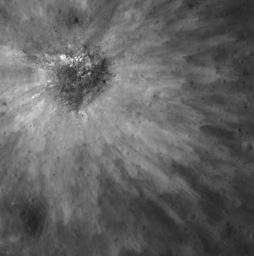Intricate Young Ejecta Blanket in Ancient Murchison Crater
Caption:
Overlapping petals of bright ejecta illustrate the complexity of ejecta emplacement, even in smaller impact events. The source crater is ~120 meters in diameter and lies on the floor of Murchison Crater, one of the
Constellation Program
regions of interest. Image size is 500-meter x 500-meter from LROC NAC frame M111599349RE; north is up.
A complex ejecta blanket is still preserved around this unnamed young crater, ~120 meter in diameter at 4.757° N, 359.5° E. Numerous discrete fingers of bright material ejected from the crater can be seen overlapping one another. A rough approximation of the crater depth based on its diameter suggests that the bright material was excavated from within tens of meters beneath the original surface.
Just north of the rim, a much smaller, younger crater is superimposed on the bright ejecta. That this crater and its ejecta appear to be dark against the underlying bright ejecta blanket shows that it excavated darker material. Based on this crater's size (~14 m diameter), material ejected during its formation would have come from only a few meters deep. It appears that the original surface had a thin dark layer of material overlying a brighter subsurface. This contrast is an excellent example of how scientists use impacts craters, of all sizes, to probe the subsurface.
The light and dark patterns in the ejecta are revealed quite clearly because the Sun was high when this image was taken: the incidence, i.e., the angle between the Sun and the zenith (straight overhead), was 29°. Such illumination highlights variations in surface brightness; for the same reason, topographic shading is more muted.
Background Info:
NASA's Goddard Space Flight Center built and manages the mission for the Exploration Systems Mission Directorate at NASA Headquarters in Washington. The Lunar Reconnaissance Orbiter Camera was designed to acquire data for landing site certification and to conduct polar illumination studies and global mapping. Operated by Arizona State University, the LROC facility is part of the School of Earth and Space Exploration (SESE). LROC consists of a pair of narrow-angle cameras (NAC) and a single wide-angle camera (WAC). The mission is expected to return over 70 terabytes of image data.
Cataloging Keywords:
| Name |
Value |
Additional Values |
| Target |
Moon |
|
| System |
Earth |
|
| Target Type |
Satellite |
|
| Mission |
Lunar Reconnaissance Orbiter (LRO) |
|
| Instrument Host |
Lunar Reconnaissance Orbiter |
|
| Host Type |
Orbiter |
|
| Instrument |
Lunar Reconnaissance Orbiter Camera (NAC) |
|
| Detector |
|
Narrow Angle Camera (NAC), Wide Angle Camera (WAC) |
| Extra Keywords |
Crater, Grayscale, Impact |
| Acquisition Date |
|
| Release Date |
2010-02-09 |
| Date in Caption |
|
|
| Image Credit |
NASA/GSFC/Arizona State University |
| Source |
photojournal.jpl.nasa.gov/catalog/PIA12951 |
| Identifier |
PIA12951 |

 Planetary Data System
Planetary Data System
